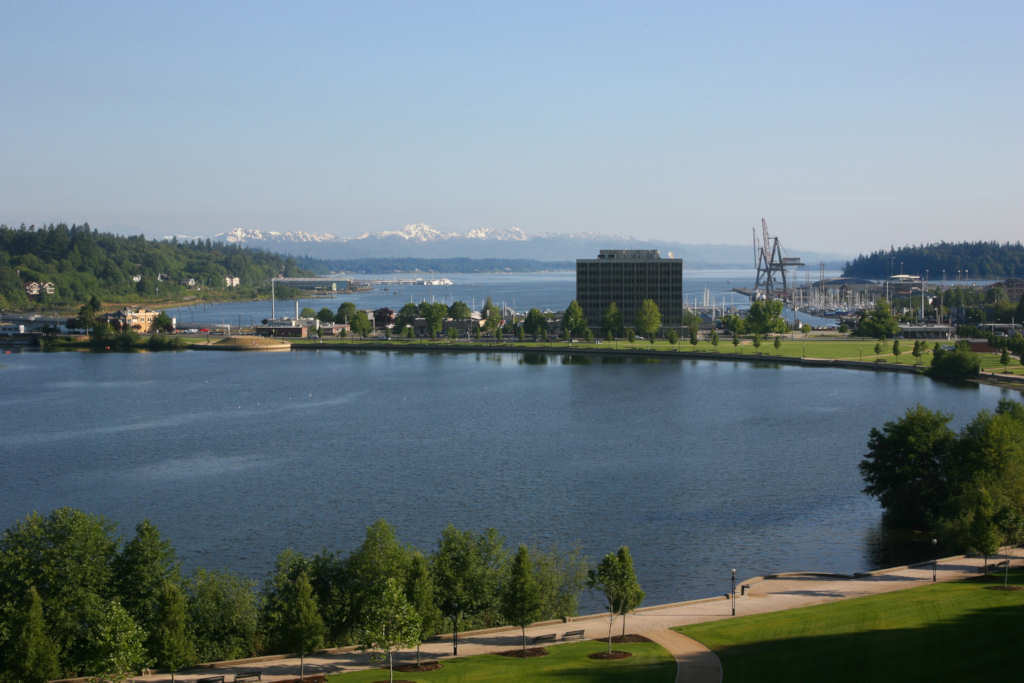Construction and Maintenance Cost of Turning Capitol Lake into Tidal Mud Flats
Denis Curry – Updated - June, 2014
This is an update of a March, 2012 paper (see below).
Since over two years have elapsed since the original report, the costs (in terms of out-of-pocket expenditures and not including lost revenues and economic activity) are sure to have risen relative to the necessary tasks involved and the time frames available for project completion.
To briefly summarize the 2012 paper:
- The CLAMP committee cost comparisons of a managed lake versus an estuary were skewed in favor of dam removal due to its definition of a “managed lake” dredged to a depth of 13 feet for 50 years and ignoring the costs of dredging Budd Inlet.
- CLAMP’s cost estimates were completed by the engineering firm of Moffatt and Nichol (M&N). Using 2006 dollars, M&N estimated costs of $90.3 million. They assumed at 2012 date for project start up after an extended period for permitting and a contested environmental impact statement. Their adjusted estimate was $112.9 million.
- An analysis by C. Stewart Gloyd, P.E. raised questions with both the estimates for the 5th Avenue bridge and the railroad bridge. His revisions brought the costs to $125.6 million.
- As of 2012 no decision had yet been made regarding the fate of the Lake and at that time the earliest start would have been 2013. The estimates were therefor revised using M&N’s cost adjustment factors to a new total of $157 million.
Subsequent to the 2012 paper, four events have occurred that affect the amount of cost to be estimated and the time frame in which the costs would be incurred. These are:
- The Puget Sound Near Shore Ecosystem Restoration Project (PSNERP) conceptual engineering analysis of the “Deschutes River Estuary Restoration” project (aka dam removal project). Although not a true restoration of the estuary as it existed before the dam was constructed, the report contains important data on the extent of dredging in the lake basin.
- The Olympia Yacht Club’s dredging of silt build-up in lower west Budd Inlet that provides valuable information on the costs of salt water dredging.
- The State Department of Enterprise Services (DES) contract with the firm of Floyd Snider to estimate the costs of permitting a 100,000 cubic foot (cy) dredge of the lake.
- An impending agreement by DES to contract with the Ruckleshaus Center for an effort to resolve issues related to the fate of the lake.
The following steps were taken to update the cost estimates in the 2012 paper to encompass a 20 year timeline:
- The PSNERP dredging estimate in the lake basin of 487,000 cubic yards was verified as being identical to the M&N estimates.
- Cost adjustments over time were based on 3.5% per year per the M&N estimates. This includes 2% for increased costs and 1.5% decrease in the value of the dollar per the Federal Reserve Bank statistics.
- A timeline change wherein the earliest time to start any dam removal project would be 2017 to accommodate the Ruckleshaus effort. To accomplish this would require a decision by the State Capitol Committee to recommend dam removal, a decision by the Legislature to change the statutes declaring Capitol Lake to be a part of the Capitol Campus and an initial appropriation of $6.9 million for engineering and permitting. (While this time frame is likely to be overly optimistic we wanted these estimates to present the lowest possible costs to remove the dam)
- An appropriation in 2019 of $7.5 million to complete permitting and resolve a contentious EIS process.
- A project completion cost of $166.3 million in 2023 for a total project cost of $180.7 million to remove the dam and accomplish the necessary infrastructure changes. This amount does not include dredging costs in Budd Inlet.
- An inflow of silt into the lake and, subsequently, to Budd Bay of 35,000 cubic yards per year. The silt build-up in the bay over the extended time needed to complete the dam removal project will require a dredge of 350,000 cubic yards in 2025 and a second dredge in 2030 of 175,000 cubic yards at higher salt water dredging costs. Based on the 2014 experience of the Olympia Yacht club, the costs for salt water dredging associated with dam removal are estimated to be $77.4 million. The twenty year total cost of removing the Fifth Avenue dam therefore totals slightly over $258 million.
- Further project delays will only serve to increase these costs.
The costs of removing the Fifth Avenue regulating dam and associated Budd Inlet dredging costs can be contrasted to the cost of maintaining Capitol Lake over 20 years. These costs are based on the CLIPA White Paper and have been adjusted using the same inflation factors as were used in the costs of dam removal.
The costs include removing 880,000 cubic yards of silt from the lake through a series of five maintenance dredges. This will be sufficient to remove 25 years of silt inflow to the lake at 35,000 cubic yards per year. The costs also include needed maintenance work on the dam in the first ten year period and the permitting cost estimated by Floyd-Snider for DES.
The accumulated 20 year cost to maintain Capitol Lake totals $39.7 million or 15% of the 20 year cost of dam removal and Budd Inlet dredging.
The Detailed Cost Calculations are pages 3, 4, & 5 in the PDF version (7 pages) of this report.
Original Report - March 2012
The CLAMP Recommendation
In 2009, the Capitol Lake Adaptive Management Program (CLAMP) steering committee recommended the removal of the 5th Avenue Dam and returning to estuarial tidal mud flats. One of the major justifications was its contention that this would be the far less costly alternative. The principle reason for the cost disparity was that the committee’s “Managed Lake” alternative called for dredging the entire lake to a depth of 13 feet.
This amount of dredging was not only unnecessary but raised significant issues of dredge spoil disposal at significant cost. The way the alternative was designed made it almost a surety that it would cost more than dam removal. In view of the subsequent controversy surrounding the recommendation, CLAMP’s estimates of construction and maintenance costs require close examination.
CLAMP's Moffatt & Nichol Estimated Costs
The CLAMP cost estimates for dam removal were based on a 2007 analysis conducted by the engineering firm of Moffatt & Nichol of Seattle. Their estimates were stated in terms of 2006 dollars and are set forth in DEFS Engineering Design and Cost Estimates – Final Report, 2/9/2007. The comparisons used in this analysis reflect M&Ns Alternative B which increased the width of the BNSF railroad crossing to improve tidal circulation and reduce hydraulic stress.
M&N’s estimate called for a total project cost of $90.3 million. The underlying construction cost that would need to be appropriated following permitting was estimated to be $63.3 million. The estimates assumed approval of dam removal in 2007 and a five year period of environmental review and permitting. This longer than normal period of time was felt necessary due to the significant environmental issues involved. M&N assumed project start-up in 2012 and inflated their estimates by 3.5% per year. This resulted in an adjusted project cost of $112.9 million.
Independent Analysis by C. Stewart Gloyd
A subsequent analysis conducted by C. Stewart Gloyd, P.E. raised questions with both the estimates for the Fifth Avenue Bridge and the railroad bridge components. In his opinion the 2006 costs for these elements were $10.3 million too low. A major reason was the suggested freeway style design of the Fifth Avenue Bridge.
Mr. Gloyd suggests a more likely (and more aesthetic) approach would be to design the bridge to be similar to the new Fourth Avenue bridge. When adjusted to 2012 using M&N’s inflation rate, the project cost would be increased by $12.7 million to a total of $125.6 million if Mr. Gloyd’s bridge recommendations were incorporated.
Reference Estuary Infrastructure Costs Review by C. Stewart Gloyd
Mud Flat Project Timing & Costs
A major factor influencing costs is project timing. M&N’s estimates were based on a project start date of 2012 (this year). As of now, no decision has been made on the fate of the lake. Setting aside the strong public sentiment for retaining Capitol Lake, the earliest time a decision could be made to remove the dam would be in 2013. This would require an appropriation of at least $6 million (half of the M&N adjusted cost estimate) to fund the first two years of permitting.
Assuming this actually took place at a time of limited state funds and that the process could be completed in five years, the absolute earliest time the actual project could begin would be July, 2019 since it would require an appropriation by the Legislature of approximately $145 million. When added to the earlier cost of $12 million (M&N’s estimate) for permitting, the total cost of eliminating Capitol Lake to create tidal mud flats would have come to 157 million dollars.
In addition to the actual project cost, there would be a need to periodically dredge Lower Budd Inlet. According to state estimates, 6 feet of sediment will accumulate in Budd Inlet every ten years. This would add approximately $87.2 million* to long term costs for an estimated 50 year total of at least 244 million dollars.
Keep in mind, these are conservative estimates based on M&N’s inflation assumption of 3.5%. Between 2006 and 2010, the R.S. Means construction cost index for the Tacoma area increased at an annual average rate of 3.8%. Since all future estimates of cost increases are conjectural, this analysis chose to use the M&N assumptions.
*The additional $87.2 million figure is the midpoint of the Herrera Environmental Consultants estimates in Capitol Lake Alternatives Analysis (101 pg PDF at Wa State DES) – Public Review Draft and are not adjusted for inflation.
Cost impacts to local government
Cost impacts that should be of concern to local government include the potential shifting of responsibility to the local level. It is quite possible that the State could consider the round-about linkage to Deschutes Parkway and a new Fifth Avenue bridge to be the City of Olympia’s responsibility. Also, if the dam was removed it is unlikely that the State would consider dredging Budd Inlet to be their responsibility.
The added sediment would greatly affect the working waterfront with severe economic consequences for the City, the County and the Port of Olympia. The estimated economic benefit to the community of the working waterfront is nearly $24 million annually and the Marine Terminal operations of the Port were responsible for over $225 million in benefits in 2009. Sediment buildup could also affect LOTT’s ability to treat wastewater, potentially resulting in higher costs passed on to ratepayers.
All of these factors would put pressure on Thurston County to assume responsibility for dredging. In short, a decision to remove the dam could have a substantial financial impact at the local level.
Fiscally Responsible Approach - The CLIPA White Paper
A far more fiscally responsible approach has been offered by the Capitol Lake Improvement and Protection Association (CLIPA) in its 2010 White Paper. This approach recommends initiating the permitting process as soon as possible and estimates a ten year cost to maintain the lake of $23.5 million.
Following up on the $200,000 appropriated by the Legislature in 2011, the permitting process would proceed far more rapidly than that estimated for dam removal. The total 50 year cost (in current dollars) would be less than $50 million. Longer term costs would need to be adjusted to reflect inflation.
It is clear from this analysis that CLAMPs contention that removal of the dam is less costly than maintaining the lake is severely flawed. Not only are the ten year costs of dam removal far higher than maintaining the lake ($157 million versus $23.5 million) the long term costs of maintaining and improving the lake are also far less.
Construction and Maintenance Cost of Turning Capitol Lake into Tidal Mud Flats
by: Denis CurryAn analysis of the long term costs of construction and maintenance to turn Capitol Lake into a mud flat.


